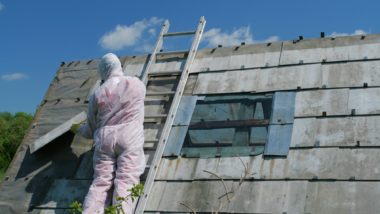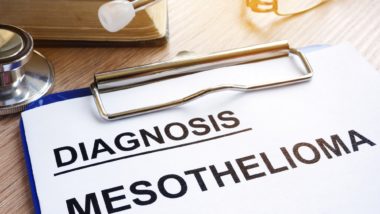Top Class Actions’s website and social media posts use affiliate links. If you make a purchase using such links, we may receive a commission, but it will not result in any additional charges to you. Please review our Affiliate Link Disclosure for more information.
Asbestos lung cancer may be a lifelong condition, even if treatment is effective at helping the disease go into remission.
What is Asbestos Lung Cancer?
In the United States, lung cancer is the leading cause of cancer deaths. Every year, lung cancer reportedly kills more people than colon cancer, prostate cancer, ovarian cancer, and breast cancer combined.
Like any other type of lung cancer, lung cancer caused by asbestos affects the tissue of the lungs. In the early stages of the disease, patients may not experience extreme symptoms. However, late-stage lung cancer can be accompanied by a variety of symptoms including coughing, coughing up blood, shortness of breath, chest pain, hoarseness, weight loss, bone pain, and headaches.
According to the American Cancer Society, inhaling asbestos fibers can increase the risk of developing lung cancer. Due to the long latency period associated with asbestos cancers, exposed individuals may not experience symptoms of the disease until at least 15 years after they are exposed. Individuals are reportedly most often exposed to asbestos during the course of their occupation.
How is Lung Cancer Treated?
According to the Mayo Clinic, treatment of lung cancer will be determined based on the type and stage of the cancer in addition to patient preferences. A patient’s oncologist will be able to tailor an individual plan to best handle the disease while aiming for the best possible outcomes.
Regardless of whether or not lung cancer is caused by asbestos exposure, treatment will often involve surgery, radiation therapy, and chemotherapy.
Surgical interventions aim to remove the cancerous cells from the lungs. During a wedge resection, the surgeon only removes the tumor in addition to a margin of healthy tissue. A segmental resection will remove a larger portion of the lung than a wedge resection, but will not remove an entire lobe. A lobectomy removes one complete lobe of the lung while a pneumonectomy removes the entire lung.
Radiation therapy may be used to kill cancer cells in the body. Using high powered energy beams, radiation therapy pinpoints the affected areas of the body and kills the cancerous cells. Radiation therapy is reportedly used before or after surgery. In many cases, radiation is used in conjunction with chemotherapy treatments.
Chemotherapy treatments involve using strong medications to kill cancer cells in the body. This form of treatment may be used after surgery and in conjunction with radiation therapy to ensure that all cancerous cells in the body are eliminated.
Other treatment options may include radiosurgery, targeted drug therapy, and immunotherapy. If lung cancer has progressed to the point that it is terminal, doctors may utilize palliative care to reduce pain and symptoms for a patient’s remaining time.
What is Asbestos and How Would I be Exposed to it?
Asbestos is a naturally occurring mineral that has been used for centuries because it is lightweight, strong, heat resistant, fire resistant and is a good insulating material. Unfortunately, asbestos also is a very dangerous carcinogen.

Amphibole asbestos includes tremolite, actinolite, anthophyllite, crocidolite, and amosite, all of which have straight, brittle fibers that don’t lend themselves as easily to industrial applications.
Back in the 1940s, asbestos was prevalent in shipbuilding, insulation, vehicle manufacturing, firefighting, and construction. There’s no safe level of asbestos exposure, but low levels of asbestos fibers exist in land, water, and air.
People who are exposed to asbestos in greater amounts and for a longer period of time are most at risk of developing asbestos lung cancer.
One of the largest releases of asbestos fibers occurred during the Sept. 11, 2001 attacks on the World Trade Center in New York City. When the Twin Towers were hit by hijacked airplanes, the towers collapsed and hundreds of tons of asbestos-filled the air, along with bits of glass, steel, lead, and jet fuel from the doomed airplanes. Because asbestos exposure can take 20 to 50 years to manifest as cancer, many of the first responders, volunteers, city workers and students who lived and worked at the area at the time could still suffer the consequences of breathing in those toxins for months.
Can Lung Cancer from Asbestos Be Cured?
Unfortunately, there is no “cure” for cancer – whether or not it is caused by asbestos. With early treatment and a comprehensive plan from an oncologist, patients may be able to go into remission. However, individuals who have had cancer will be forced to live with the risk of recurrence for their whole life.
Lung cancer is the leading cause of death among women since 1987. News-Review notes that nearly twice as many women die from lung cancer annually as those who die from breast cancer.
The Center for Disease Control and Prevention explains that more than 4,800 deaths from lung cancer are linked to asbestos exposure. Though many people associate lung cancer with smoking, Health Central reports that as many as one in five Americans who die from lung cancer never used tobacco.
One element that makes lung cancer dangerous is that sometimes, it can be symptomatic in its early stages. Some patients may develop symptoms like a persistent cough, blood produced when they cough, or shortness of breath. However, others may not know they have the disease until it is in its later stages. Around 25 percent of patients are only diagnosed with lung cancer after they had a diagnostic test done for something completely unrelated, and lung cancer is discovered by chance.
According to Lung Cancer Awareness Month, early detection is a patient’s best chance of surviving lung cancer. Reportedly, diagnosing lung cancer when it is only at stage one as opposed to stage four raises a patient’s five-year survival rate from just 4 percent to 55 percent, making the lack of symptoms particularly challenging in the diagnostic process. Some patients who are predisposed to lung cancer may benefit from routine screenings, to help catch lung cancer early, if it develops.
Do YOU have a legal claim? Fill out the form on this page now for a free, immediate, and confidential case evaluation. The attorneys who work with Top Class Actions will contact you if you qualify to let you know if an individual asbestos lawsuit or asbestos class action lawsuit is best for you. [In general, asbestos lung cancer lawsuits are filed individually by each plaintiff and are not class actions.] Hurry — statutes of limitations may apply.
ATTORNEY ADVERTISING
Top Class Actions is a Proud Member of the American Bar Association
LEGAL INFORMATION IS NOT LEGAL ADVICE
Top Class Actions Legal Statement
©2008 – 2024 Top Class Actions® LLC
Various Trademarks held by their respective owners
This website is not intended for viewing or usage by European Union citizens.
Get Help – It’s Free
Join a Free Asbestos Lung Cancer Class Action Lawsuit Investigation
If you or a loved one were exposed to asbestos and developed mesothelioma, lung cancer, or cancer in the lining of the lungs, abdomen or chest cavity, you may be able to take legal action against the companies responsible. Don’t delay – in most states the statute of limitations is two years to file an asbestos lawsuit after you’re diagnosed. Obtain a free and confidential case evaluation be filling out the form below.
An attorney will contact you if you qualify to discuss the details of your potential case at no charge to you.
PLEASE NOTE: If you want to participate in this investigation, it is imperative that you reply to the law firm if they call or email you. Failing to do so may result in you not getting signed up as a client or getting you dropped as a client.
Oops! We could not locate your form.












